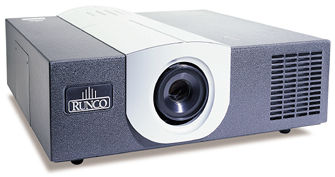Runco VX-1000c DLP Projector
 Enter Runco's newest projector, the VX-1000c. This model continues in Runco's intelligent tradition of combining a projector with a scalar to create a total system. After all, no projector is better than the scaler that feeds it . The system includes the VX-1000c DLP -based projector, which used Texas Instruments' 1, 80,:720 mirror array, and an outboard scaler that's also available separately as the PFP controller.
Enter Runco's newest projector, the VX-1000c. This model continues in Runco's intelligent tradition of combining a projector with a scalar to create a total system. After all, no projector is better than the scaler that feeds it . The system includes the VX-1000c DLP -based projector, which used Texas Instruments' 1, 80,:720 mirror array, and an outboard scaler that's also available separately as the PFP controller.
The projector and processor area are as stylish as one can expect black boxes to be. Most of the projector's style comes form its gray, slightly off-center, cylindrical, canonlike lines housing. The box's size is surprising: it's at least two to four times larger than the typical DLP projector (which can be as small as a three-pack of VHS tapes,) but it's still half the size of our reference CRT=based projector (Runco's DTV-991).

The VX-1000c's lack of exterior connectors preserves some of its aesthetic appeal. For invisible wiring, you can run wire directly from the floor or ceiling to the connectors that reside in the recessed space of the projector's belly. Using the supplied adapters, regular six-conductor phone wire, and a five-wire analog video able, you can link the projector's input and control jack to the outboard PFP Controller. The processor has one compos site input, one S-video input, and one interlace component (Y/Pb/Pr) input, plus another input for either RGB or component HD signals. This is adequate but may require some external switching. The external processor scales NTSC signals to 720p, which matches the projector's native resolution. Since the HD inputs bypass the processor, the projector scales them. I find the two-piece projector/processor approach to be ideal, as it allows you to route all of your video signals at the equipment rack and then send the signal to the display. A digital link between the two would be nice, though. Beware that the projector's RGBHV connectors are configured abnormally (GBRHV) and are dissimilar to the processor's array (HVBGR).

The inclusion of manual zoom and focus controls is another noticeable quirk. You might expect a projector in this price range to have electronic, remote-accessible controls. Then again, it's probably just as well, since you or your installer should only have to adjust these controls once. Given the system's ergonomics, manual focus is much faster. The remote and front-panel controls are so slow that it seems like nothing is happening; then, when you press the button again, the display makes two changes instead of one.
Overall, the projector is relatively easy to set up. Then again, it's a DLP projector: There's not much to do beyond the focus and zoom part. If you mount the projector too high or too low, a substantial lens shift can move the image nearly the full height of the screen. If that doesn't do the trick, an effective electronic keystone adjustment can straighten things out somewhat, with little or no degradation of picture quality. This is an exceptional amount of control for a fixed-pixel projector.
Ease of use is a different story. Both the PFP's front panel and the small remote have only five main buttons, which cycle (slowly) through the available aspect ratios and source inputs. My first review sample had trouble syncing to HDTV, but this appeared to be a fluke, as a subsequent sample worked flawlessly. You can preserve each input's picture-parameter adjustments separately, which is great. An IR-based universal remote, such as the Philips Pronto (or someone who's handy with a paper clip), can utilize the convenient, direct-access control to each source and aspect ratio via the recessed, numbered buttons located on the lower half of the supplied remote. Thanks to the RS-232 inputs on the projector and processor, you can also use the VX-1000c with computer-based automation systems like those from Crestron and AMX. Runco figures that the latter two options are the most likely methods in which someone would control a product of this type, and they're probably right.





























































